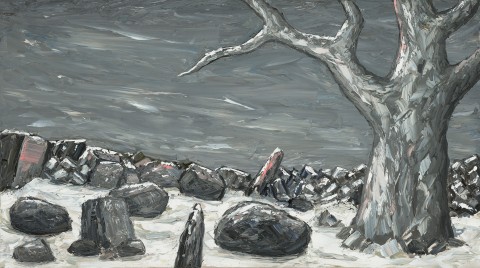PAINTING (SNOW SCENE - GREY TREE), 2006
PETER BOOTH
oil on canvas
45.5 x 81.5 cm
signed and dated verso: BOOTH 2006
inscribed verso: 62
Rex Irwin Art Dealer, Sydney (label attached verso)
Private collection, Sydney, acquired from the above in 2007
Peter Booth, Rex Irwin Art Dealer, Sydney, 19 June – 14 July 2007, cat. 8 (illus. in exhibition catalogue)
From his auspicious debut in the ground-breaking exhibition The Field held at the National Gallery of Victoria in 1968, Peter Booth has proceeded to achieve international recognition as one of the most important and influential artists of his generation. If it was his large, monochromatic abstract works which initially attracted widespread acclaim however, today it is his immensely vivid and painterly figuration for which Booth is best renowned. Drawing upon epic legends of the past and prophecies for an imagined future, these dramatic, poetic images of the human spirit poignantly explore fundamental human emotions and anxieties, issues of spiritual turmoil, social alienation and the devolution of civilisation. Thus framed within a world both imagined and observed, Booth’s vision transcends the immediate or particular to acquire a universality comparable to the musings of his greatest artistic predecessors, including Goya, Blake and Shakespeare.
Painting (Snow Scene – Grey Tree), 2006 relates to the celebrated group of ‘snow paintings’ which Booth commenced during the winter of 1989. Preceded by a series of wet and windy landscapes, the quiet chill of the snow paintings represented a transition in Booth’s oeuvre which he parallels to the journey in Milton’s epic sequence of poems, Paradise Lost (1667) to Paradise Regained (1671). More specifically however, the series was inspired by the artist’s re-reading of Shakespeare’s Macbeth (1606) with its chilling themes of ambition and evil bearing resonance for Booth in contemporary Western greed and disregard for the planet. Accordingly, in many of these works, snow throws a white curtain of silence over the charred and blackened landscape, heralding the end of man’s aggression towards his fellow man and the environment like the omen of destruction foretold by the decimation of Birnam Wood in Macbeth.
Yet to focus solely upon the immediate, pessimistic impact of such works is to ignore the lyricism – even optimism – frequently underlying Booth’s imagery. Indeed, discussing the snow motif which has its origins in the artist’s childhood memories of Sheffield, Jason Smith elucidates ‘...for Booth, the winter landscape is one of serenity and the promise of renewal. It reminds us of the resilience of nature and is a metaphor for human endurance against the physical and psychological trials of life...’1
1. Smith, J., ’Peter Booth: Human / Nature’ in Peter Booth: Human / Nature, National Gallery of Victoria, Melbourne, 2003, pp. 14 – 15
VERONICA ANGELATOS
